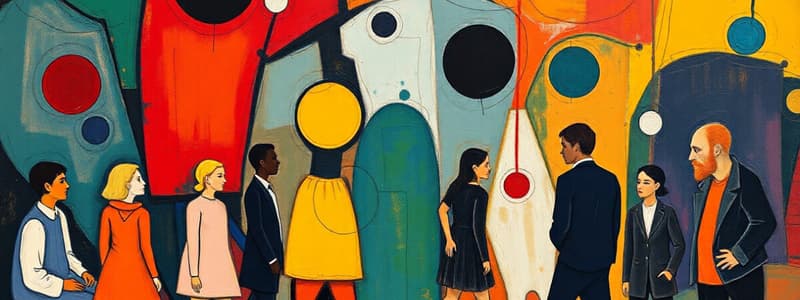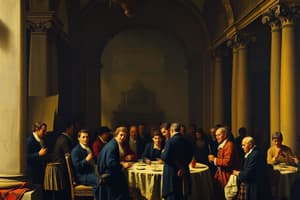Podcast
Questions and Answers
How did Durkheim differentiate suicide rates between Catholic and Protestant communities?
How did Durkheim differentiate suicide rates between Catholic and Protestant communities?
- Catholic communities had stricter laws against suicide, deterring individuals.
- Protestant communities experienced greater economic hardship than Catholic communities.
- Protestant communities offered more individual freedom, leading to higher rates.
- Catholic communities fostered greater social connections, buffering against suicide. (correct)
Which characteristic is most indicative of Durkheim's concept of 'anomie' during periods of rapid social change?
Which characteristic is most indicative of Durkheim's concept of 'anomie' during periods of rapid social change?
- A breakdown of norms and regulations, leading to social instability. (correct)
- Greater adherence to legal structures and formal contracts.
- A strengthening of social bonds due to shared hardship.
- An increase in religious observance and traditional values.
In what fundamental way does organic solidarity differ from mechanical solidarity, according to Durkheim?
In what fundamental way does organic solidarity differ from mechanical solidarity, according to Durkheim?
- Organic solidarity is typical of rural settings, whereas mechanical solidarity is found in urban environments.
- Organic solidarity is characterized by a complex division of labor and diverse values, whereas mechanical solidarity features shared values and simpler labor roles. (correct)
- Organic solidarity relies on kinship and friendship ties, whereas mechanical solidarity depends on contractual obligations.
- Organic solidarity results in lower crime rates due to increased social control, whereas mechanical solidarity leads to higher crime rates due to lack of opportunity.
How would Durkheim likely view a modern, urban society characterized by highly specialized professions and diverse belief systems?
How would Durkheim likely view a modern, urban society characterized by highly specialized professions and diverse belief systems?
Considering Durkheim’s perspective, which societal shift would most likely contribute to a state of anomie?
Considering Durkheim’s perspective, which societal shift would most likely contribute to a state of anomie?
How did strain theory influence government policies aimed at reducing crime and deviance?
How did strain theory influence government policies aimed at reducing crime and deviance?
Which of the following best describes the core argument of relative deprivation theory as it relates to crime?
Which of the following best describes the core argument of relative deprivation theory as it relates to crime?
According to strain theory, which group is most likely to conform to societal norms?
According to strain theory, which group is most likely to conform to societal norms?
How does general strain theory broaden the scope of Merton's original strain theory?
How does general strain theory broaden the scope of Merton's original strain theory?
What was a primary critique of Merton's original strain theory?
What was a primary critique of Merton's original strain theory?
According to strain theory, which mode of adaptation is most associated with individuals who accept societal goals but reject the legitimate means to achieve them?
According to strain theory, which mode of adaptation is most associated with individuals who accept societal goals but reject the legitimate means to achieve them?
Which adaptation in Merton's strain theory is characterized by rejecting both the cultural goals and the institutionalized means, while also actively seeking to replace them with new goals and means?
Which adaptation in Merton's strain theory is characterized by rejecting both the cultural goals and the institutionalized means, while also actively seeking to replace them with new goals and means?
Which of Merton's modes of adaptation is most descriptive of individuals who abandon societal goals but still adhere to the prescribed means of achieving them?
Which of Merton's modes of adaptation is most descriptive of individuals who abandon societal goals but still adhere to the prescribed means of achieving them?
How does strain theory classify its approach to understanding crime and deviance?
How does strain theory classify its approach to understanding crime and deviance?
Among Merton's adaptations to strain, which is most likely to be associated with individuals who are considered 'double failures'?
Among Merton's adaptations to strain, which is most likely to be associated with individuals who are considered 'double failures'?
Given the modes of adaptation within strain theory, which of the following individuals would be considered least likely to engage in criminal behavior?
Given the modes of adaptation within strain theory, which of the following individuals would be considered least likely to engage in criminal behavior?
If a person strongly believes in obtaining wealth but feels incapable of achieving it through conventional work, and subsequently starts selling drugs, which adaptation of strain theory best describes this scenario?
If a person strongly believes in obtaining wealth but feels incapable of achieving it through conventional work, and subsequently starts selling drugs, which adaptation of strain theory best describes this scenario?
A social activist engages in civil disobedience, openly defying laws they perceive as unjust, while advocating for a new social order. Which adaptation in Merton's typology best characterizes this activist's behavior?
A social activist engages in civil disobedience, openly defying laws they perceive as unjust, while advocating for a new social order. Which adaptation in Merton's typology best characterizes this activist's behavior?
According to Merton's strain theory, what is a primary factor contributing to anomie in societies?
According to Merton's strain theory, what is a primary factor contributing to anomie in societies?
How did Merton's approach to understanding deviance differ from that of the Chicago School?
How did Merton's approach to understanding deviance differ from that of the Chicago School?
In the context of structural-functionalism, what role does crime play in society, according to theorists like Durkheim and Merton?
In the context of structural-functionalism, what role does crime play in society, according to theorists like Durkheim and Merton?
Which of the following best describes Merton's concept of a 'criminogenic' society?
Which of the following best describes Merton's concept of a 'criminogenic' society?
How might a structural functionalist explain the existence and persistence of poverty within a capitalist society?
How might a structural functionalist explain the existence and persistence of poverty within a capitalist society?
What was the significance of Merton publishing "Social Structure and Anomie" in 1938?
What was the significance of Merton publishing "Social Structure and Anomie" in 1938?
How did the historical context of the Roaring Twenties and the Dirty Thirties influence Merton's thinking on anomie and deviance?
How did the historical context of the Roaring Twenties and the Dirty Thirties influence Merton's thinking on anomie and deviance?
How does Merton's strain theory build upon Durkheim's concept of anomie?
How does Merton's strain theory build upon Durkheim's concept of anomie?
Flashcards
Anomie
Anomie
A state of normlessness and breakdown of social solidarity.
Mechanical Solidarity
Mechanical Solidarity
Social cohesion in rural areas through shared values and kinship.
Organic Solidarity
Organic Solidarity
Social cohesion in urban areas through diverse values and specialized roles.
Strain Theory
Strain Theory
Signup and view all the flashcards
Consensus Theory
Consensus Theory
Signup and view all the flashcards
The American Dream
The American Dream
Signup and view all the flashcards
Cultural Strain
Cultural Strain
Signup and view all the flashcards
Modes of Adaptation
Modes of Adaptation
Signup and view all the flashcards
Conformity
Conformity
Signup and view all the flashcards
Innovation
Innovation
Signup and view all the flashcards
Retreatism
Retreatism
Signup and view all the flashcards
Ritualism
Ritualism
Signup and view all the flashcards
Rebellion
Rebellion
Signup and view all the flashcards
American Dream
American Dream
Signup and view all the flashcards
General Strain Theory
General Strain Theory
Signup and view all the flashcards
Relative Deprivation Theory
Relative Deprivation Theory
Signup and view all the flashcards
Access to Legitimate Means
Access to Legitimate Means
Signup and view all the flashcards
Sociological Theorists of Strain
Sociological Theorists of Strain
Signup and view all the flashcards
Mutually Reinforcing
Mutually Reinforcing
Signup and view all the flashcards
The Roaring Twenties
The Roaring Twenties
Signup and view all the flashcards
Black Tuesday
Black Tuesday
Signup and view all the flashcards
Structural Functionalism
Structural Functionalism
Signup and view all the flashcards
Criminogenic Society
Criminogenic Society
Signup and view all the flashcards
Differential Association
Differential Association
Signup and view all the flashcards
Study Notes
Anomie and Social Strain Theory
- Emile Durkheim, a significant figure in sociology, greatly influenced strain theory.
- Durkheim's consensus theory suggests social order arises from widespread agreement on norms and values.
- He observed that suicide rates differ across social groups and attributed, in part, differences to societal factors like community and religion, not just individual psychology.
- He believed that rapid social change, particularly the shift toward industrialization and urbanization, could cause social disruption and anomie.
- Durkheim defined anomie as a state of normlessness, characterized by the breakdown of social order and the absence of clear social expectations.
- This breakdown of social solidarity and social standards led to greater rates of crime.
Mechanical and Organic Solidarity
- Mechanical Solidarity: Found in traditional, rural societies, characterized by shared values, similar occupations, and close-knit communities.
- Examples include agricultural communities and small towns.
- Individuals are bound by similarity; their kinship and shared values are strong.
- Organic Solidarity: Found in complex, modern societies. Specialized roles, diverse values, and impersonal relationships characterize this type of solidarity.
- Examples include urban, industrial settings and factories.
- Individuals are connected by interdependence rather than similarity.
Robert K. Merton's Strain Theory
- Robert K. Merton agreed with Durkheim on the role of social structures in influencing individual behavior.
- He proposed strain theory, positing that societal pressures lead to deviance.
- In the US, the "American Dream" fosters the pursuit of wealth, yet unequal access to resources creates strain.
- Merton asserted that individuals experience strain when culturally valued goals (like wealth) are not attainable using socially approved means (like education and employment).
Modes of Adaptation
- Conformity: Accepting social goals and means to reach them.
- Innovation: Accepting social goals but rejecting means by using alternative, illegal methods to reach them.
- Ritualism: Rejecting social goals but accepting social means.
- Retreatism: Rejecting both social goals and means.
- Rebellion: Rejecting current social goals and means, while attempting to create new ones.
Later Developments and Criticisms
- Later theorists, including Blau and Blau, expanded on relative deprivation theory, emphasizing that the gap between aspirations and obtainable rewards contributes to crime.
- Critics of strain theory point out its limited scope and its lack of focus on individual agency. For example, it doesn't account for why some people in similar positions don't turn to crime.
Studying That Suits You
Use AI to generate personalized quizzes and flashcards to suit your learning preferences.
Related Documents
Description
Explore anomie and Emile Durkheim's Social Strain Theory. Rapid social change may cause social disruption and anomie. Anomie is defined by the breakdown of social order and the absence of clear social expectations.




